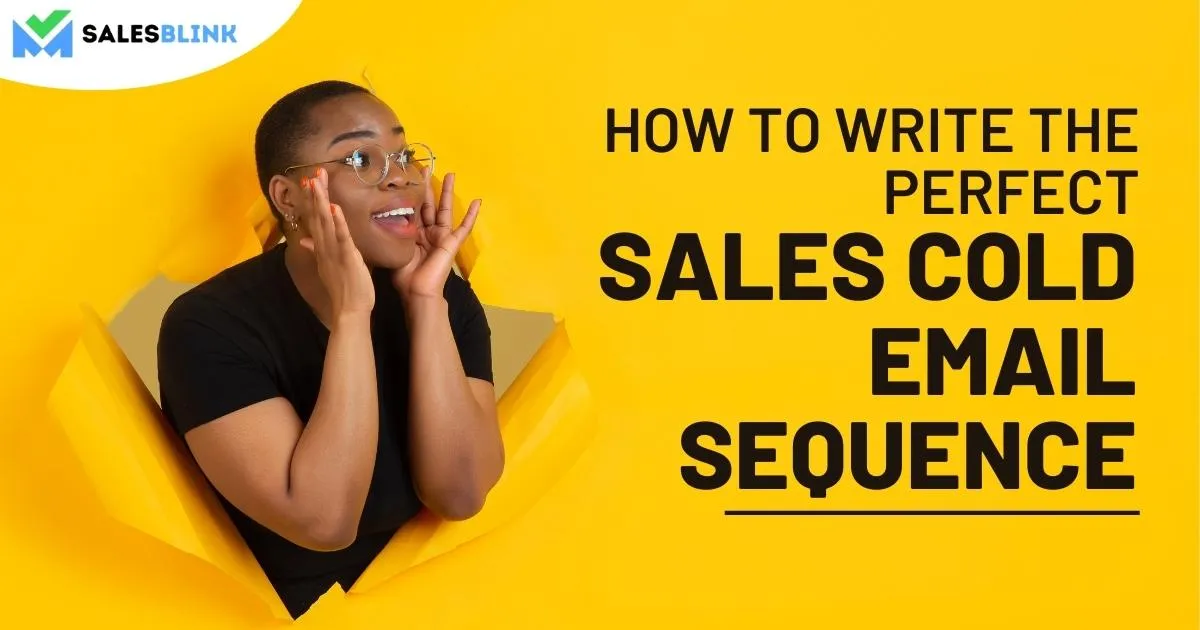How To Write The Perfect Sales Cold Email Sequence?
In today’s fast-paced business landscape, cold email outreach remains one of the most effective ways to connect with potential clients, boasting an impressive ROI of $38 for every $1 invested. However, sending just one email isn’t enough. Your prospects are often swamped with messages, and it’s easy for your first email to slip through the cracks. This is why creating a strategic sales cold email sequence is essential. With the right approach and best email sequence software, your response rates can triple, turning cold leads into warm opportunities.
Whether you’re new to this or looking to refine your strategy, mastering email sequencing is key to maximizing your outreach efforts.
Let’s explore how to craft a powerful email sequence that delivers results.
Table Of Contents
- What Is An Email Sequence?
- Characteristics Of A Perfect Sales Cold Email Sequence
- Types Of Email Sequence
- Steps To Create Email Sequence With SalesBlink
- Cold Email Sequence Template
- Tips to Consider When Creating an Effective Cold Email Sequence
- How To Add Value To The Email Sequences?
- Create Your Cold Email Sequence Today!
- FAQs
What Is An Email Sequence?
An email sequence is a series of automated emails sent to prospects at predetermined intervals or triggered by specific events. This powerful tool allows you to engage with potential clients without needing to manually send each message. There are two primary types of email sequences:
Sales Email Sequences: These are used in cold email campaigns to generate leads and drive sales.
Marketing Email Sequences: These are designed to nurture leads, building relationships over time.
For this discussion, we’ll focus on the sales cold email sequence. Understanding the basics of cold email outreach is crucial for crafting effective emails that resonate with your audience. With the right email sequence software and adherence to outreach sequence best practices, you can maximize the impact of your campaigns.
Characteristics Of A Perfect Sales Cold Email Sequence
To carry out cold email outreach that increases conversions, you must focus on several parameters. It is essential to build a long-lasting relationship with the prospect and not sound too sales. You have put your best foot forward with your email. Let’s take a brief look at all you have to bear in mind while crafting cold emails.
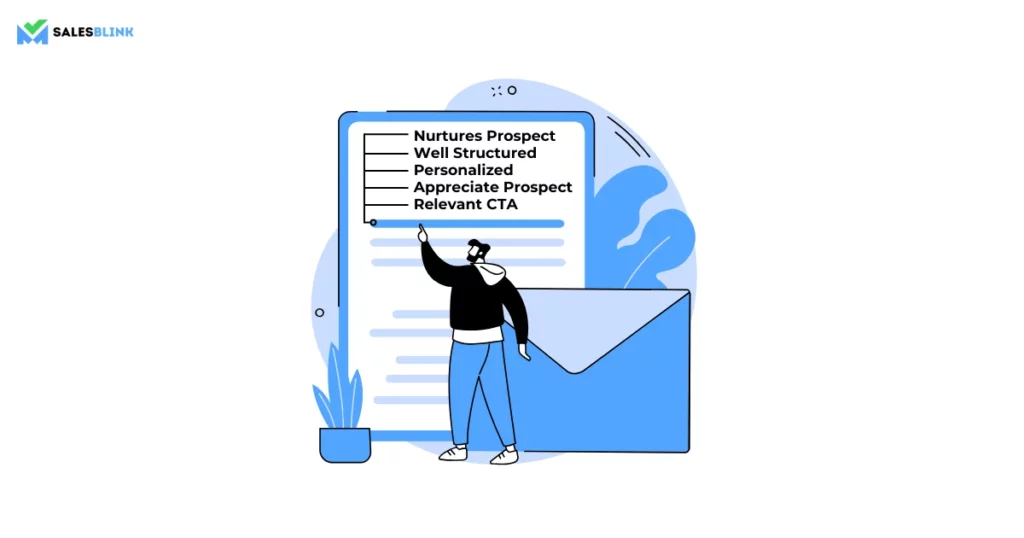
- Nurtures prospect: A great cold email sequence focuses on building a relationship, not just making a sale. Share useful tips and insights that relate to the prospect’s industry and challenges. This way, you’re adding value and showing genuine interest in their success, gradually turning them into a more engaged lead.
- Well structured: Think of your email sequence like a friendly conversation. Start with a warm introduction, follow with a helpful message, and wrap up with a clear, inviting call to action. Keeping things organized and easy to follow helps maintain interest and makes your emails feel more personal and approachable.
- Personalized: Personal touches make a big difference. Use the prospect’s name and mention specifics about their company or role. Tailoring your message to their unique situation shows you’ve done your homework and genuinely care about offering something that’s relevant to them.
- Appreciate Prospect: Show gratitude for their time and attention. Acknowledge their achievements or milestones, and let them know you value their consideration. A little appreciation goes a long way in building a positive connection and making your outreach feel more sincere.
- Look for Common Ground: Find something you both share, like a mutual contact, similar challenges, or common interests. Mentioning these shared elements helps establish a rapport and makes your message feel more relatable and genuine.
- Fulfill Prospect’s Need: Focus on how you can help solve their specific problems. Be clear about how your product or service addresses their needs and benefits them directly. This way, you’re not just selling; you’re offering a real solution to their challenges.
- Establishing brand (First Preference of Prospect): Make your brand stand out by showcasing what makes it unique. Share success stories or key differentiators that highlight why you’re the best choice. Building a strong, positive impression helps position your brand as the go-to option when they’re ready to make a decision.
- Relevant CTA: Use a CTA that seems relevant and is not too aggressive and salesy in nature if you want to increase reply rates. Something on the lines of – ‘Do you want to know more?’ Rather than booking a demo directly, the prospects would like to know a little more about your offering.
Types Of Email Sequence
There exist different types of email sequences, and they have different purposes. Take a look at them below,
1. Nurturing Email Sequence
Using a nurturing email sequence, you introduce yourself to the prospect. Even though the prospects subscribe to your newsletter, they are not ready to purchase. With a nurturing email sequence, you can make them more likely to purchase by providing value, giving social proof, and overcoming sales objections.
Purpose: To build a relationship and warm up prospects who aren’t yet ready to buy.
Content: Introduce yourself with a friendly tone, offer valuable insights or resources, and share success stories. Focus on building trust and showing genuine interest in their needs.
Template:
Subject: Hi [First Name], Let’s Explore How We Can Help!Hi [First Name],
I’m [Your Name], and I wanted to personally welcome you to our community! I know you’re still exploring your options, so I’ve put together a few resources that might be really useful for [specific challenge or industry].
Check out our latest guide on [relevant topic] here [link]. If you have any questions or just want to chat about how we can support your goals, I’m here!
Looking forward to connecting!
Best,
[Your Name]
2. Engagement Email Sequence
With an engagement email sequence, you can build a relationship with prospects. The aim is to get them interested in what you offer and stay on top of their mind. It is possible to find out which prospects engaged with the email by tracking opens and clicks. You can then add those individuals to other sequences that cater exclusively to their Stage in the buyer’s journey.
Purpose: To foster interest and keep your brand top of mind.
Content: Share engaging and relevant content, ask open-ended questions, and encourage interactions. Use tracking to understand their interests and tailor future messages.
Template:
Subject: What Do You Think About [Topic]?
Hi [First Name],
Hope you’re having a great day! I came across an article about [relevant topic] that I thought you’d find interesting: [link].
I’d love to hear your thoughts on it! If you have any questions or just want to discuss the topic further, hit reply.
Looking forward to your feedback!
Best,
[Your Name]
3. Conversion Email Sequence
In this email sequence, you ask the prospect to take action, such as book a demo or schedule a meeting. You can craft the email copy in a way that the prospect gets driven to act on the CTA. Use the sequence to make the recipient act on it.
Purpose: To prompt the prospect to take a specific action, like booking a demo.
Content: Clearly explain the benefits of taking the next step and make it easy for them to act. Your goal is to drive them to a call-to-action.
Template:
Subject: Ready to See [Your Product] in Action?
Hi [First Name],
I’d love to show you exactly how [Your Product] can help with [specific need or challenge]. How about we schedule a quick demo? You can pick a time that works best for you here: [link to calendar].
Let’s take the next step and explore how we can make a difference for you!
Best,
[Your Name]
4. Follow-Up Email Sequence
If a prospect doesn’t reply to your email, it doesn’t necessarily mean that they don’t have an interest in your product or service. There might be a need for a few touchpoints before they act. With a follow-up email sequence, you can reconnect with prospects following a few attempts to reach out. It minimizes the need for sales reps to send emails manually.
Purpose: To re-engage prospects who haven’t responded yet.
Content: Be polite and persistent. Offer additional value or a gentle nudge to check if they’re still interested.
Template:
Subject: Still Interested in [Topic]?
Hi [First Name],
Just wanted to follow up on my last email about [topic]. I completely understand how busy things can get, so I wanted to check if you had a chance to review it.
If you have any questions or need more info, just let me know. I’m here to help!
Best regards,
[Your Name]
5. Reminder Email Sequence
You may get super-excited when a prospect books a demo with you. It may seem like they are planning to close a deal with you. But, what would happen when the prospect ghosts you? That’s where reminders come into play. They help ensure that leads don’t forget about the demo they booked or the meeting they scheduled.
Purpose: To remind prospects of upcoming meetings or demos.
Content: Send a friendly reminder to ensure they remember their appointment. Offer assistance if they need to reschedule.
Template:
Subject: Reminder: Your Upcoming Demo with Us!
Hi [First Name],
Just a quick reminder about our demo scheduled for [date and time]. We’re excited to show you how [Your Product] can [specific benefit].
If you need to reschedule or have any questions before the meeting, just let me know. Looking forward to our chat!
Best,
[Your Name]
6. Re-Engagement Email Sequence
You require a re-engagement email sequence as a last resort to revive the contacts that have gone cold or are uninterested. This sequence aims to make recipients open the emails and perform some action. If it doesn’t evoke a response, you can remove the prospect from your database to ensure your mailing list stays healthy.
Purpose: To reconnect with prospects who have gone silent or lost interest.
Content: Reach out with a compelling reason to re-engage. Offer new insights or updates to spark their interest again.
Template:
Subject: Let’s Catch Up, [First Name]!
Hi [First Name],
It’s been a while since we last connected, and I wanted to touch base to see if there’s still interest in [relevant topic or solution].
We’ve recently [mentioned new development or insight], and I think it could be really valuable for you. If you’re open to it, let’s have a quick chat and explore how we can support your goals!
Best wishes,
[Your Name]
Steps To Create Email Sequence With SalesBlink
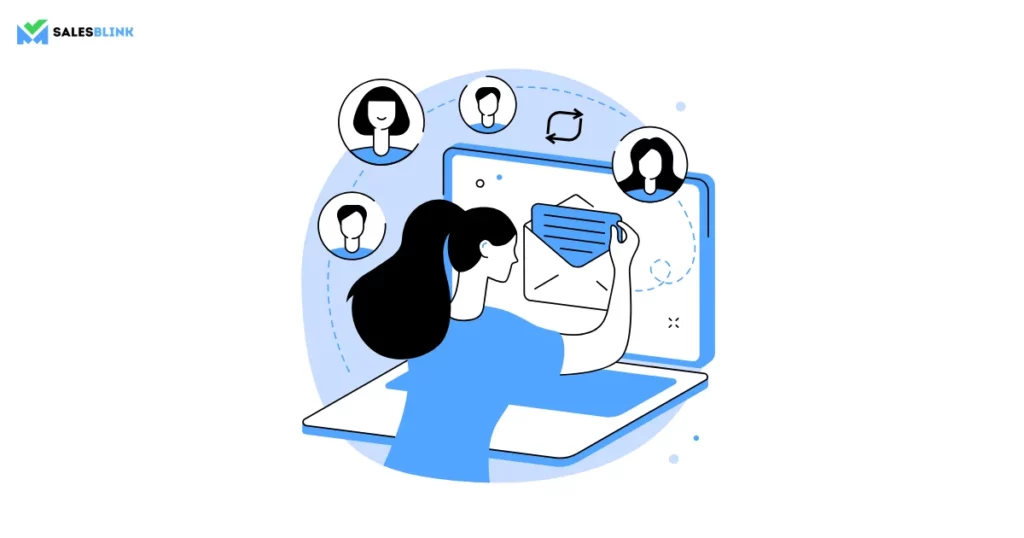
Sign up to Salesblink
Getting started is simple! Head over to the SalesBlink website and sign up for an account. Just fill in your details, and you’ll be ready to dive into crafting your email sequences. If you’re new, there’s usually a free trial option to help you get a feel for the platform.
Connect Your Gmail With Salesblink
To make your email outreach smooth, you’ll need to connect your Gmail account. Go to the integration settings and follow the prompts to authorize SalesBlink to access your Gmail. This will allow you to send emails directly from the platform without switching between tabs.
Create a New Email Sequence
Once your account is set up and connected, navigate to the ‘Email Sequences’ tab. Click on ‘Create New Sequence’ to start building your customized sequence. Here, you can name your sequence and set up the stages of your email outreach.
Define Your Sequence Steps
In the sequence builder, add the steps of your email sequence. You can start by drafting your initial email, then add follow-up emails based on how the recipient engages with your messages. Customize each step with specific content, timing, and conditions.
Personalize Your Emails
Tailor your emails to fit each recipient. Use SalesBlink’s features to insert personalization tokens, like their name or company, to make each message feel more personal. This increases the chances of your emails being opened and read.
Set Up Triggers and Timing
Decide when and how often each email in your sequence should be sent. You can set triggers based on the recipient’s actions, like opening an email or clicking a link. This helps in automating your outreach while keeping it relevant and timely.
Review and Test Your Sequence
Before launching your sequence, review each step to ensure everything looks good and functions as intended. Use the preview feature to see how your emails will appear. It’s also a good idea to send test emails to yourself to check for any issues.
Launch Your Sequence
Once you’re happy with your sequence, hit ‘Launch’. SalesBlink will start sending your emails according to the schedule you’ve set. Keep an eye on the performance metrics to see how your sequence is performing and make adjustments as needed.
Monitor and Optimize
Track the results of your email sequence through SalesBlink’s analytics dashboard. Look at open rates, click-through rates, and responses to gauge effectiveness. Based on this data, tweak your sequence to improve performance over time.
This process should help you set up and run effective email sequences using SalesBlink, making your outreach more streamlined and impactful. If you have any questions or run into issues, SalesBlink’s support team is there to help you along the way.
Cold Email Sequence Template
Here are the cold email templates that can find their way in your sequences,
1. The initial email to congratulate the prospect for their achievement
Subject: Are you available for a chat?
Email Body:
Hello {{Prospect’s_name}},
I work with {{industry_name}} and therefore follow the industry news closely. I came to know that you {{achievement}} and want to congratulate you for the achievement.
When you reach this milestone, {{topic}} is essential. Therefore, I felt that you would like to know how we have helped {{competitors}}. You can check our customer testimonials here. If you wish to know more about our offering, let’s connect sometime this week. Here’s a link to my calendar – click.
Thanks,
Sara
2. Follow up after 24 hours, providing a valuable resource
Subject: Free tool for you
Email Body:
Hello {{Prospect’s_name}},
I am sending you a follow-up email to provide you with a free tool that will come in handy. It helps in {{mention_use}} and can save a considerable amount of your time and money.
Click here {{link}} to access this tool. If you feel that it is indeed helpful and want to know more about our flagship solution {{product/service_name}} and how it can benefit you, you can schedule a meeting with me. I am sharing my calendar link, feel free to pick a date – Click
Thanks,
Sara
3. Another follow up email after 24 hours of silence from the prospect
Subject: Connecting with you
Email Body:
Hello {{Prospect’s_name}},
I understand that you are busy and not able to connect. Work and family life can be taxing at times.
You can connect with me on weekends too if it is suitable for you or after your office hours. I want to help you out with {{pain_point}} and feel that there can be nothing better than {{product/service_name}}.
Feel free to pick a date and time off my calendar to schedule a meeting {{link}}.
Thanks,
Sara
4. Final follow-up email after not getting a reply to any of your emails
Subject: Can I close your file?
Email Body:
Hello {{Prospect’s_name}},
I haven’t heard back from you, and it may be because you are pretty occupied or not interested in the offer. If so, can you permit me to close your file? If you want to connect, I will be delighted to help you. Just reply to this email.
Thanks,
Sara
The last email is the breakup email, and it works most of the time due to the prospect’s fear of missing out (FOMO)
The sequence of cold email templates above is a relatively short one. However, there can be matters that involve more significant decisions and have a higher risk where sequences require more emails from your end. The sales cold email sequence can run for 2 weeks and may seem like the following,
1. Initial cold email
2. Send a gentle reminder 2-3 days after the first email
3. Send an email adding value 3-4 days after the previous email
4. Send another email adding value 3-4 days after the previous email
5. Send breakup email 4-5 days after the previous email
Tips to Consider When Creating an Effective Cold Email Sequence
- Know your target audience: Get to know who you’re talking to. Imagine having a friendly chat where you’re genuinely interested in their world—what their day-to-day looks like, and what keeps them up at night. This way, your emails feel like they’re speaking directly to their specific needs and interests.
- Align email sequence with buyer’s journey: Think of your email sequence as a series of helpful conversations. If someone is just starting to explore their options, start with useful information and gentle introductions. As they show more interest, dive deeper into how you can help. It’s like guiding a friend through a decision rather than rushing them.
- Effective presentation of an offer: When you present your offer, show how it fits into their life. Instead of just listing features, explain how it will make their job easier or help them achieve their goals. Picture it like recommending a tool to a friend and explaining how it will solve a specific problem they’ve shared with you.
- Use generic template: Avoid generic messages that feel like they could be sent to anyone. Instead, personalize your emails to reflect their unique situation. Imagine you’re writing a note to a friend, addressing their specific needs and interests, rather than using a one-size-fits-all approach.
- Short and precise content: Keep your emails brief and focused. Think of it like having a quick, meaningful chat where you get straight to the point. Busy people appreciate when you respect their time by delivering your message clearly and succinctly.
- Focus on the problem-solving aspect: Emphasize how you can help solve their specific issues. Instead of just showcasing features, talk about how your solution can make their day easier or help them reach their goals. It’s like offering a practical solution to a problem they’ve mentioned, rather than just describing what you have.
How To Add Value To The Email Sequences?
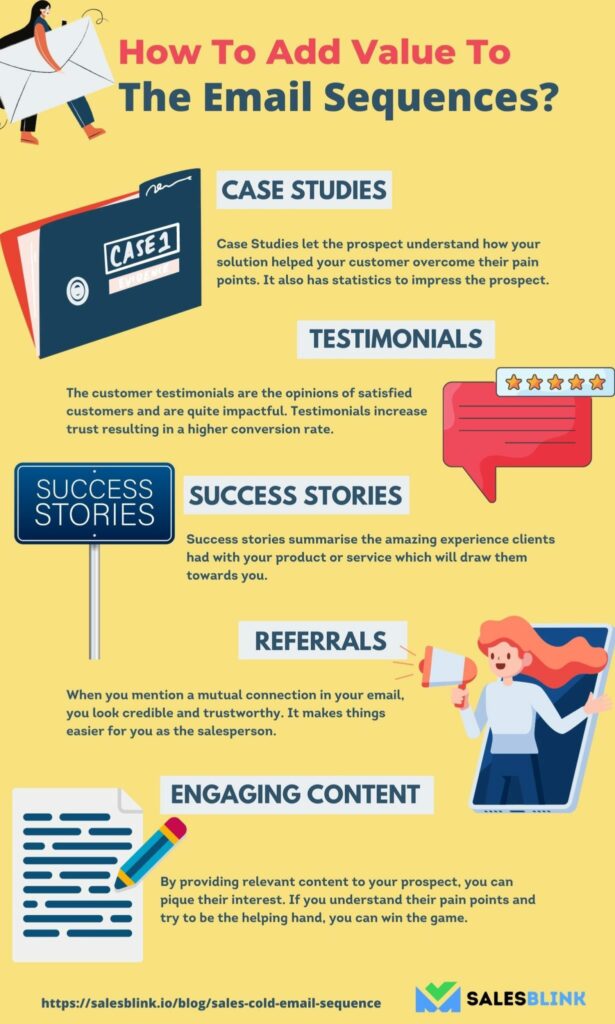
- Add case studies: Case studies can help get you great results as they let the prospect understand how your solution helped your customer overcome their pain points. It also has statistics to impress the prospect further.
- Add CTA: Use friendly, inviting calls to action. Instead of a formal request, try something like, “If you’re curious to see how this could work for you, let’s set up a quick call. It’ll be worth your time!” This keeps the tone conversational.
- Testimonials: The customer testimonials are the opinions of satisfied customers and are quite impactful. If the prospect reads the testimonials, they will trust you more, increasing the chances of conversion.
- Success Stories: Success stories can grab the prospect’s interest as they summarise the amazing experience clients had with your product or service. You can present facts to prospects and draw them towards you using stories.
- Referrals: It is possible to close more deals using referrals. When you mention a mutual connection in your email, you look credible enough, and the prospect is more likely to trust you. It often works as the ice-breaker in the conversation and makes things easier for you as the salesperson.
- Engaging Content: By providing relevant content to your prospect, you can pique their interest in you and your product or service. If you understand their pain points and try to be the helping hand they always wanted, you can win the game.
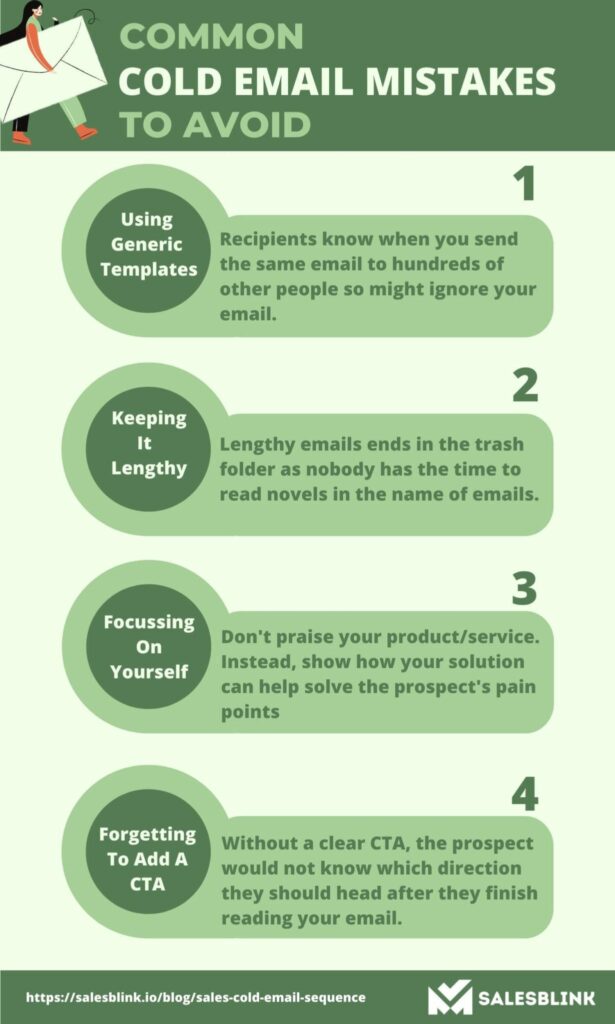
Create Your Cold Email Sequence Today!
A sales cold email sequence can be quite effective in converting leads to paying customers. As we have already seen above, there are many different types of sequences, from nurturing leads to sequences for following up with prospects. The length of the sequence is not fixed and depends on several factors. Some sequences can do their job with just 3 emails, while others require more emails. As you can see, a lot goes into crafting a cold email campaign, but you can get the job done faster if you have the help of cold email software like SalesBlink.
You can thank us once you start seeing results!
FAQs
Ideally, your email sequence should have 4 emails if you want an affirmative response. At times even one email may do the trick. But mostly, you need at least 2-4 emails to get a response from the prospect.
While there is no hard and fast rule for the length of your sales email sequences, try to spread them across a minimum of 10 days. The number also depends on your buyer persona.
It is a good practice to wait for at least 48 hours before sending your follow-up email. It would help if you tried to plan the gap between emails accordingly to get the best results.
A good sequence usually includes 5 to 7 emails, providing multiple touchpoints without overwhelming prospects.
It’s best to wait 2 to 4 days between each email to maintain engagement without overwhelming your audience.
